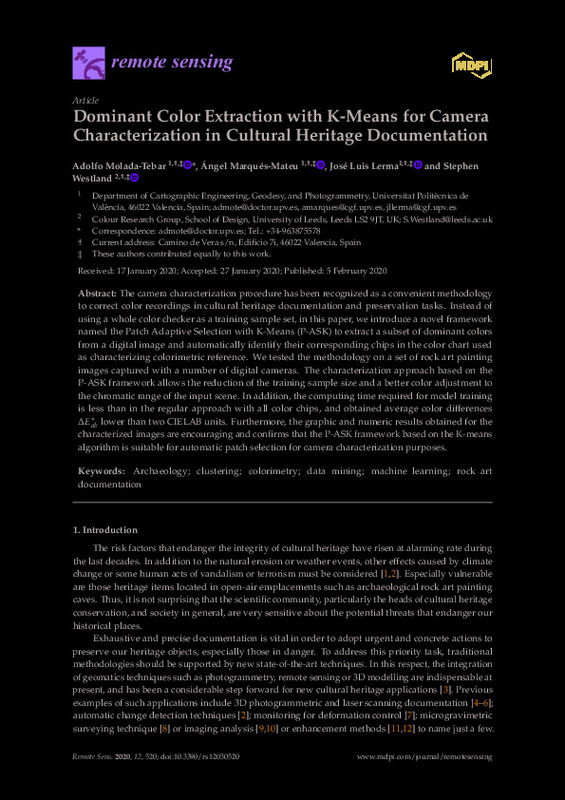JavaScript is disabled for your browser. Some features of this site may not work without it.
Buscar en RiuNet
Listar
Mi cuenta
Estadísticas
Ayuda RiuNet
Admin. UPV
Dominant Color Extraction with K-Means for Camera Characterization in Cultural Heritage Documentation
Mostrar el registro sencillo del ítem
Ficheros en el ítem
| dc.contributor.author | Molada-Tebar, Adolfo
|
es_ES |
| dc.contributor.author | Marqués-Mateu, Ángel
|
es_ES |
| dc.contributor.author | Lerma, José Luis
|
es_ES |
| dc.contributor.author | Westland, Stephen
|
es_ES |
| dc.date.accessioned | 2023-04-26T18:01:09Z | |
| dc.date.available | 2023-04-26T18:01:09Z | |
| dc.date.issued | 2020-02 | es_ES |
| dc.identifier.issn | 2072-4292 | es_ES |
| dc.identifier.uri | http://hdl.handle.net/10251/192975 | |
| dc.description.abstract | [EN] The camera characterization procedure has been recognized as a convenient methodology to correct color recordings in cultural heritage documentation and preservation tasks. Instead of using a whole color checker as a training sample set, in this paper, we introduce a novel framework named the Patch Adaptive Selection with K-Means (P-ASK) to extract a subset of dominant colors from a digital image and automatically identify their corresponding chips in the color chart used as characterizing colorimetric reference. We tested the methodology on a set of rock art painting images captured with a number of digital cameras. The characterization approach based on the P-ASK framework allows the reduction of the training sample size and a better color adjustment to the chromatic range of the input scene. In addition, the computing time required for model training is less than in the regular approach with all color chips, and obtained average color differences Delta E-ab(*) lower than two CIELAB units. Furthermore, the graphic and numeric results obtained for the characterized images are encouraging and confirms that the P-ASK framework based on the K-means algorithm is suitable for automatic patch selection for camera characterization purposes. | es_ES |
| dc.description.sponsorship | This research is partly funded by the Research and Development Aid Program PAID-01-16 of the Universitat Politecnica de Valencia, through FPI-UPV-2016 Sub 1 grant. | es_ES |
| dc.language | Inglés | es_ES |
| dc.publisher | MDPI AG | es_ES |
| dc.relation.ispartof | Remote Sensing | es_ES |
| dc.rights | Reconocimiento (by) | es_ES |
| dc.subject | Archaeology | es_ES |
| dc.subject | Clustering | es_ES |
| dc.subject | Colorimetry | es_ES |
| dc.subject | Data mining | es_ES |
| dc.subject | Machine learning | es_ES |
| dc.subject | Rock art documentation | es_ES |
| dc.subject.classification | INGENIERIA CARTOGRAFICA, GEODESIA Y FOTOGRAMETRIA | es_ES |
| dc.title | Dominant Color Extraction with K-Means for Camera Characterization in Cultural Heritage Documentation | es_ES |
| dc.type | Artículo | es_ES |
| dc.identifier.doi | 10.3390/rs12030520 | es_ES |
| dc.relation.projectID | info:eu-repo/grantAgreement/UPV//PAID-01-16/ | es_ES |
| dc.rights.accessRights | Abierto | es_ES |
| dc.contributor.affiliation | Universitat Politècnica de València. Escuela Técnica Superior de Ingeniería Geodésica, Cartográfica y Topográfica - Escola Tècnica Superior d'Enginyeria Geodèsica, Cartogràfica i Topogràfica | es_ES |
| dc.description.bibliographicCitation | Molada-Tebar, A.; Marqués-Mateu, Á.; Lerma, JL.; Westland, S. (2020). Dominant Color Extraction with K-Means for Camera Characterization in Cultural Heritage Documentation. Remote Sensing. 12(3):1-22. https://doi.org/10.3390/rs12030520 | es_ES |
| dc.description.accrualMethod | S | es_ES |
| dc.relation.publisherversion | https://doi.org/10.3390/rs12030520 | es_ES |
| dc.description.upvformatpinicio | 1 | es_ES |
| dc.description.upvformatpfin | 22 | es_ES |
| dc.type.version | info:eu-repo/semantics/publishedVersion | es_ES |
| dc.description.volume | 12 | es_ES |
| dc.description.issue | 3 | es_ES |
| dc.relation.pasarela | S\402299 | es_ES |
| dc.contributor.funder | Universitat Politècnica de València | es_ES |








